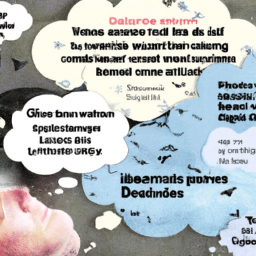I have observed that people are fascinated by the mysteries of the mind. Among them, the world of dreams is especially captivating. Dreams, a universal phenomenon, have been a topic of research for centuries in different cultures worldwide.
The scientific study of dreams is called oneirology, which comes from the Greek word ‘oneiros’meaning ‘dream.’In this article, I will explore what oneirology is, its history, purpose, types of dreams, role of subconscious mind, tools and techniques used in studying it as well as practical applications and future development.
Oneirology is a complex field that aims to understand why we dream and how to use these experiences to improve our lives. It involves exploring the content and meaning behind our dreams through various methods such as dream analysis and interpretation.
As you read on in this article about oneirology you will learn about its historical roots dating back to ancient civilizations who believed in prophetic dreaming and divination techniques for interpreting them. You will be able to gain insight into how different types of dreams can affect us emotionally or physically depending on their context or content.
Key Takeaways
- Oneirology is the scientific study of dreams, including their causes, functions, interpretation, and analysis.
- Dream analysis techniques involve keeping dream journals, using psychoanalytic approaches, and exploring cultural significance.
- Dreams serve as a way to process emotions and experiences from waking life, and they help us problem-solve by allowing us to think creatively.
- Oneirology aims to understand why we dream and how to use these experiences to improve our lives.
Definition of Oneirology
If you’ve ever wondered what the study of dreams is all about, look no further than oneirology. Oneirology is the scientific study of dreams, including their causes and functions, as well as their interpretation and analysis.
It encompasses a wide range of topics, from sleep disorders to dream symbolism and meaning. The scope of oneirology includes a variety of techniques for analyzing and interpreting dreams.
Some methods include keeping dream journals, using psychoanalytic approaches to uncover unconscious thoughts and emotions, and exploring the cultural significance of symbols in dreams. By understanding these techniques, researchers can help patients overcome sleep disorders or gain insight into their own psychological states.
Now let’s take a closer look at the history of dream interpretation.
History of Dream Interpretation
The history of dream interpretation dates back to ancient times, where it held significant cultural value. For instance, the Greeks and Egyptians believed that dreams were prophetic messages from the gods and would use them for divination.
In some cases, dreams were even seen as a means of healing, with certain individuals gifted with the ability to interpret them accurately. Over time, various cultures developed their own methods of interpreting dreams, often based on religious or spiritual beliefs.
These interpretations often had practical applications in areas such as medicine, politics, and warfare. Today, we continue to study dreams through oneirology and other fields in order to better understand their role in human psychology and behavior.
As we delve further into this topic, it becomes clear that understanding the purpose of dreams is essential for unlocking their full potential.
The Purpose of Dreams
One thing we all wonder about is why we dream and what purpose it serves in our lives. As someone who’s studied the psychological significance, interpretation, and analysis of dreams, I can tell you that there are several theories out there.
One of the most widely accepted theories is that dreams serve as a way for us to process emotions and experiences from our waking life. This means that when we dream, our subconscious mind takes over and replays events from our day or even from long ago, but in a symbolic form.
Another theory suggests that dreams help us problem-solve by allowing us to think creatively and outside of the box. When we sleep, our brain is free to make connections between seemingly unrelated ideas or concepts. This can lead to insights and solutions that may not have been considered while awake.
Ultimately, the role of emotions and experiences in the formation of dreams cannot be understated as they provide valuable information for self-discovery and personal growth.
With this understanding of the purpose behind dreaming, let’s now explore the different types of dreams.
The Different Types of Dreams
You may be surprised to learn that your dreams can fall into several different categories, each with their own unique qualities and characteristics. Don’t worry if you haven’t heard of these types before – they’re not commonly discussed in everyday conversation.
The first type of dream is known as a lucid dream, characterized by the dreamer being aware that they’re dreaming and having some control over the dream events. These dreams often feel more realistic and can provide a sense of empowerment.
Another common type is a nightmare, characterized by feelings of fear, anxiety, or despair. Nightmares often center around common themes such as being chased or falling from great heights. Note that nightmares can have both physical and emotional effects on the body and should be addressed if they become frequent or interfere with daily life.
Lastly, there are symbolic dreams that require interpretation through analyzing the various symbols present in the dream. Understanding these symbols can provide insight into one’s subconscious thoughts and emotions.
As we delve further into understanding our dreams, it becomes clear that our subconscious minds play an instrumental role in shaping our experiences during sleep.
The Role of the Subconscious Mind
Delving into the depths of our subconscious minds during sleep can be a terrifying yet exhilarating experience. Our dreams, which are products of our subconscious thoughts and emotions, provide an insight into our deepest desires and fears. The role of the subconscious mind in shaping our dreams has been extensively studied by researchers for years.
Dream analysis techniques have been developed to interpret the significance of various elements in our dreams, such as symbols, emotions, and recurring themes. These techniques involve analyzing the content of each dream to identify patterns that may reveal underlying psychological issues or unresolved conflicts. By understanding the hidden messages in our dreams, we can gain self-awareness and potentially resolve emotional traumas that we may not even be aware of on a conscious level.
Moving onto the subsequent section about the science behind dreaming, it’s important to note that while dream analysis techniques offer insights into the subconscious mind’s workings, they’re not based on empirical evidence. However, recent advances in neuroscience have shed light on the physiological processes underlying dreaming and how it relates to memory consolidation and emotional regulation.
The Science Behind Dreaming
Exploring the science behind dreaming can reveal fascinating insights into our brains and how they function during sleep. During Rapid Eye Movement (REM) sleep stages, which occur multiple times throughout a night’s sleep cycle, the brain becomes incredibly active, almost as active as it would be when we’re awake. This is when most of our vivid dreams occur.
Researchers have used brain imaging techniques to study brain activity during REM sleep and have found that certain areas of the brain become more active than others, such as the amygdala which is responsible for processing emotions.
Dream recall techniques can also provide insights into our subconscious minds. One common technique involves keeping a dream journal by recording all details of dreams upon waking up. This not only helps with recalling dreams but may also reveal patterns or recurring themes in dreams over time.
The study of dreams, known as oneirology, uses tools and techniques like these to better understand the mysteries of why we dream and what they mean for our mental health and overall well-being.
Continuing on from this subtopic, let’s now discuss some tools and techniques used in oneirology to further explore the world of dreaming.
Tools and Techniques Used in Oneirology
By using brain imaging and dream recall techniques, researchers in oneirology gain insights into the complexities of our subconscious minds.
One tool commonly used for studying dreams is called polysomnography, which involves recording brain activity, eye movements, muscle tone, and heart rate during sleep. This data is then analyzed to identify different stages of sleep and to determine when a person is dreaming.
Another important technique used in oneirology is dream analysis. This involves exploring the content of a person’s dreams and interpreting them in order to better understand their unconscious thoughts and feelings. To help with this process, some people keep dream journals or use apps that allow for sleep tracking and record their dreams upon waking up.
By analyzing these dreams over time, researchers can gain insights into how our experiences during the day affect our subconscious mind at night.
As we continue to explore the fascinating world of oneirology, it becomes increasingly clear how much our dreams can reveal about our mental health. Understanding the connections between our dreams and emotional well-being can provide valuable insight into mental illness and help us develop more effective treatments.
Oneirology and Mental Health
Understanding the relationship between our dreams and mental health can provide valuable insights into our emotional well-being, offering us a unique window into our subconscious minds. Dream analysis has been used as a tool to explore the underlying causes of mental health issues such as anxiety, depression, and trauma.
Oneirology is the scientific study of dreams, which involves analyzing dream content and interpreting their meanings to gain insight into an individual’s psyche. Dream therapy is a form of psychotherapy that uses dream analysis to help individuals identify unresolved emotional conflicts that may be affecting their mental health.
This therapy involves exploring symbols and themes in dreams to understand how they relate to real-life experiences. By uncovering unconscious thoughts and emotions through dream analysis, individuals can work towards resolving internal conflicts for improved emotional well-being.
In the next section on practical applications of oneirology, we will explore how this field can be applied in various settings beyond clinical therapy.
Practical Applications of Oneirology
In the field of oneirology, there are several practical applications that have been developed for therapeutic purposes. One of the most common and effective methods is dream journaling. Keeping a record of our dreams can help us gain insight into our subconscious thoughts, feelings, and desires. By analyzing our dreams, we can identify patterns and themes that may be impacting our mental health and overall well-being.
To illustrate the benefits of dream journaling in a more organized manner, I present to you a table showing its therapeutic effects:
| Therapeutic Benefits of Dream Journaling |
|---|
| Helps identify recurring themes that need attention |
| Provides insight into unconscious desires or fears |
| Enhances self-awareness and personal growth |
As seen in the table above, keeping a dream journal can bring about numerous benefits to one’s psychological state. This tool allows individuals to delve deeper into their subconscious world with greater understanding. Through this practice, one has the opportunity to engage in self-reflection leading towards better emotional regulation, problem-solving skills as well as enriched creativity.
The study of dreams through oneirology continues to evolve with new insights being discovered every day. As researchers continue to explore this fascinating subject matter, we can only expect even more significant breakthroughs in the future.
Future of Oneirology
As a oneirologist, I’m excited about the future of this field and the potential for discovering more about the human mind and behavior. Advancements in technology and research have already allowed us to gain valuable insights into the workings of the brain during sleep and dreaming.
With further progress in this area, we may be able to uncover even more about how our brains process information, emotions, and memories while we sleep.
Advancements in Technology and Research
With the help of new technology, we’ve made incredible progress in delving deeper into the mysterious realm of dreams. Technological advancements have allowed us to explore and analyze the brain’s activity during sleep, providing insight into how our thoughts and emotions manifest in our dreams. Research techniques such as functional magnetic resonance imaging (fMRI) and electroencephalography (EEG) have been instrumental in uncovering the neural correlates of dreaming.
One exciting area of research is the study of lucid dreaming, where individuals are aware they are dreaming and can even control their actions within the dream. Using fMRI scans, researchers have identified specific regions of the brain that become active during lucid dreaming, including areas involved in self-awareness and decision-making. By understanding how these processes work during lucid dreaming, we may be able to develop new therapies for conditions such as post-traumatic stress disorder or depression. As technology continues to improve and research techniques advance, there is immense potential for discovering more about the human mind and behavior through studying our dreams.
Potential for Discovering More About the Human Mind and Behavior
You can’t help but feel excited about the potential for uncovering even more about your own mind and behavior through further exploration of the mysteries of dreaming.
The study of dreams, also known as oneirology, has been an area of interest for researchers and psychologists for centuries. With advancements in research methods and technology, our understanding of dreams has expanded exponentially.
Not only is the study of dreams fascinating from a scientific perspective, it also holds great potential for cultural influences. Through analyzing dream patterns across different cultures and societies, we may be able to gain insight into how cultural values and beliefs influence our subconscious thoughts and behaviors.
This information could then be used to develop interventions that promote positive mental health outcomes within specific cultural contexts.
Overall, the study of dreams provides us with a unique lens through which we can explore the complexities of human thought and behavior.
Frequently Asked Questions
Can dreams be controlled or manipulated for a specific purpose?
As a researcher in the field of dream analysis, I have found that it is possible to control and manipulate dreams through the technique of lucid dreaming. This allows for intentional exploration and processing of subconscious thoughts and emotions.
Can dreams provide insights into past traumas or repressed memories?
Dream analysis and subconscious exploration can provide insights into past traumas or repressed memories. By examining the symbolism and themes in our dreams, we can explore the deepest parts of our psyche and unlock hidden memories that may be affecting our current mental state.
Are there any cultural or societal differences in the interpretation of dreams?
I find it fascinating how cross cultural dream interpretation reveals the historical significance of dream analysis. It’s intriguing to see how different societies have approached and interpreted dreams throughout history, providing valuable insight into the human psyche. One anachronism that comes to mind is the ancient Greeks’ belief in prophetic dreaming.
Can dream interpretation be used as a diagnostic tool for psychological disorders?
Using dream interpretation in therapy to diagnose psychological disorders raises ethical concerns. While dreams can provide insight, they are subjective and not always reliable. It should be used cautiously and with other diagnostic tools.
Is there a correlation between recurring dreams and mental health issues?
As a mental health professional, I have found that recurring dreams can be indicative of underlying psychological issues. Dream therapy and analysis may uncover unresolved traumas or conflicts to improve overall mental wellbeing.
Conclusion
In conclusion, the study of dreams is known as oneirology. It has a rich history and continues to be an important field of research in psychology and neuroscience.
By exploring the purpose and different types of dreams, as well as the role of the subconscious mind, researchers are able to gain insight into our innermost thoughts and emotions. Through various tools and techniques such as dream analysis and lucid dreaming, we can further understand how our dreams relate to our mental health.
The practical applications of oneirology extend beyond just understanding ourselves better; it also has potential implications for therapeutic interventions for individuals struggling with mental health disorders. As oneirology continues to evolve, there is great potential for further advancements in this fascinating field.









